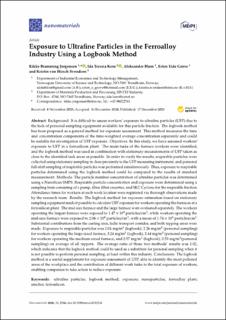| dc.contributor.author | Jørgensen, Rikke Bramming | |
| dc.contributor.author | Kero, Ida | |
| dc.contributor.author | Blom, Aleksander | |
| dc.contributor.author | Grove, Esten Eide | |
| dc.contributor.author | Svendsen, Kristin V Hirsch | |
| dc.date.accessioned | 2021-01-08T13:29:05Z | |
| dc.date.available | 2021-01-08T13:29:05Z | |
| dc.date.created | 2021-01-06T14:10:59Z | |
| dc.date.issued | 2020 | |
| dc.identifier.citation | Nanomaterials. 2020, 10 (12), 1-14. | en_US |
| dc.identifier.issn | 2079-4991 | |
| dc.identifier.uri | https://hdl.handle.net/11250/2722224 | |
| dc.description.abstract | Background: It is difficult to assess workers’ exposure to ultrafine particles (UFP) due to the lack of personal sampling equipment available for this particle fraction. The logbook method has been proposed as a general method for exposure assessment. This method measures the time and concentration components of the time-weighted average concentration separately and could be suitable for investigation of UFP exposure. Objectives: In this study, we have assessed workers’ exposure to UFP in a ferrosilicon plant. The main tasks of the furnace workers were identified, and the logbook method was used in combination with stationary measurements of UFP taken as close to the identified task areas as possible. In order to verify the results, respirable particles were collected using stationary sampling in close proximity to the UFP measuring instrument, and personal full-shift sampling of respirable particles was performed simultaneously. Thus, exposure to respirable particles determined using the logbook method could be compared to the results of standard measurement. Methods: The particle number concentration of ultrafine particles was determined using a NanoScan SMPS. Respirable particle concentration and exposure were determined using a sampling train consisting of a pump, filter, filter cassettes, and SKC Cyclone for the respirable fraction. Attendance times for workers at each work location were registered via thorough observations made by the research team. Results: The logbook method for exposure estimation based on stationary sampling equipment made it possible to calculate UFP exposure for workers operating the furnaces at a ferrosilicon plant. The mid-size furnace and the large furnace were evaluated separately. The workers operating the largest furnace were exposed to 1.47 × 104 particles/cm3, while workers operating the mid-size furnace were exposed to 2.06 × 104 particles/cm3, with a mean of 1.74 × 104 particles/cm3. Substantial contributions from the casting area, ladle transport corridor, and both tapping areas were made. Exposure to respirable particles was 2.04 mg/m3 (logbook); 2.26 mg/m3 (personal sampling) for workers operating the large-sized furnace, 3.24 mg/m3 (logbook); 2.44 mg/m3 (personal sampling) for workers operating the medium-sized furnace, and 2.57 mg/m3 (logbook); 2.53 mg/m3(personal sampling) on average of all tappers. The average ratio of these two methods’ results was 1.02, which indicates that the logbook method could be used as a substitute for personal sampling when it is not possible to perform personal sampling, at least within this industry. Conclusions: The logbook method is a useful supplement for exposure assessment of UFP, able to identify the most polluted areas of the workplace and the contribution of different work tasks to the total exposure of workers, enabling companies to take action to reduce exposure. | en_US |
| dc.language.iso | eng | en_US |
| dc.publisher | MDPI | en_US |
| dc.rights | Navngivelse 4.0 Internasjonal | * |
| dc.rights.uri | http://creativecommons.org/licenses/by/4.0/deed.no | * |
| dc.subject | ferrosilicon | en_US |
| dc.subject | smelter | en_US |
| dc.subject | ferroalloy plant | en_US |
| dc.subject | nanoparticles | en_US |
| dc.subject | exposure | en_US |
| dc.subject | logbook method | en_US |
| dc.subject | ultrafine particles | en_US |
| dc.title | Exposure to ultrafine particles in the ferroalloy industry using a logbook method | en_US |
| dc.type | Peer reviewed | en_US |
| dc.type | Journal article | en_US |
| dc.description.version | publishedVersion | en_US |
| dc.rights.holder | © 2020 by the authors. Licensee MDPI, Basel, Switzerland. This article is an open access article distributed under the terms and conditions of the Creative Commons Attribution (CC BY) license (http://creativecommons.org/licenses/by/4.0/) | en_US |
| dc.source.pagenumber | 14 | en_US |
| dc.source.volume | 10 | en_US |
| dc.source.journal | Nanomaterials | en_US |
| dc.source.issue | 12 | en_US |
| dc.identifier.doi | 10.3390/nano10122546 | |
| dc.identifier.cristin | 1866376 | |
| cristin.ispublished | true | |
| cristin.fulltext | original | |
| cristin.qualitycode | 1 | |

